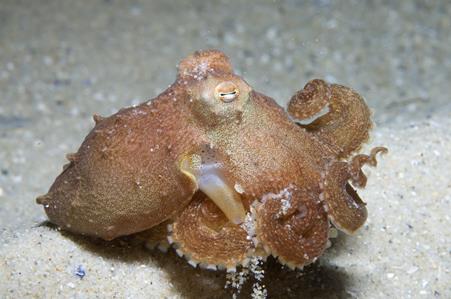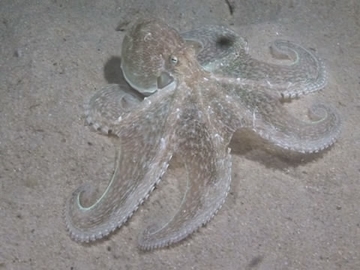General Description
Moderate-sized, muscular octopus. Body oval-shaped and rimmed around the sides by a raised skin ridge or keel. Colour generally cream to mottled orange-brown with a transverse pair of large white spots on the dorsal mantle and a white bar between the eyes. Skin covered in regular small low bumps. Fingers of skin (papillae) can be raised above the eyes and over the body. Maximum mantle length 11 cm, total length to around 36 cm.
Biology
This octopus emerges at night to forage over the sand for crabs and other crustaceans. During the day it buries in the sand or hides in shells or human refuse (such as discarded bottles). When buried it can raise one eye like a periscope above the level of the sand to check for predators before emerging. The common name of this octopus refers to the ridge of skin around the edge of the body, which may aid in gliding the octopus under the sand when it buries. This octopus buries close to the sand surface so that it can still draw clean water in to its gill cavity in order to gain oxygen. Courtship consists of males standing on their arm tips and flaring the webs as they approach females. They quickly grab the females and use their long thin modified arm tip on the third right arm to pass sperm packages into the female's oviducts. Females lay large single eggs that are attached singly to hard surfaces such as shells or human refuse. The young are well developed at hatching and immediately start foraging on the sea floor. This octopus is caught in low quantities in baitless pot fisheries in bays and inlets in South Australia and Victoria. It is sold for human consumption and as bait.
Habitat
Sand and mud substrates in coastal waters to depths of at least 250 m.
Soft substrates
Distribution guide
Southern Australia.
Species Group
Octopuses and allies › Octopuses
Depth
Shallow (1-30 m)
Deep ( > 30 m)
Water Column
Max Size
36 cm
Diet
Carnivore
Harmful
Potential to bite, especially if handled. Venom status unknown.
Commercial Species
No
Global Dispersal
Native to Australia
Identify
Conservation Status
- DSE Advisory List : Not listed
- EPBC Act 1999 : Not listed
- IUCN Red List : Not listed









